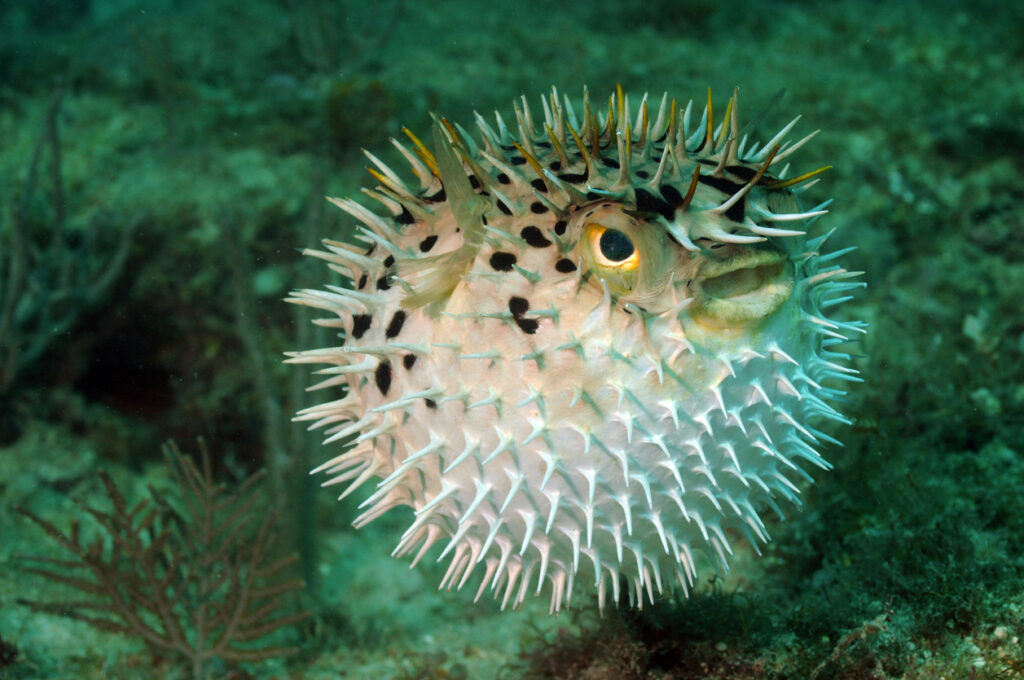Best known for its puffed-up appearance, the duly named pufferfish is an instantly recognisable sea creature. But with so many other interesting characteristics, behaviours and habits, we’re on a mission to inflate your knowledge way beyond the basics of this fish.
Allow us to blow you out of the water with some of our favourite must-know pufferfish facts!
What exactly are pufferfish?
Also known as blowfish, balloonfish and sometimes simply as puffers, pufferfish are from a large family of the order Tetraodontidae. Broken down, ‘tetra’ is Greek for four while ‘odent’ means teeth. Pufferfish are in the company of almost 200 other species within this family.
Tetraodontidae is one family of the order Tetraodontiformes, which also includes the families of porcupinefish (Diodontidae) and triggerfish (Balistidae).
They have an incredible defence mechanism
Their ability to puff up might be one of the once well-known facts about this fish, but what you might not know is that it’s an incredible defence mechanism they’ve developed. Pufferfish can inflate by either sucking up water or sometimes air into their elastic stomachs, a process known as buccal pumping. This allows them to grow up to four times their normal size. They can only do this for short periods, though, since it requires up to five times more oxygen than normal.
To help them inflate into their spherical shape, pufferfish don’t have any ribs and have developed modified gill muscles to aid the buccal pumping process. The skin on their stomachs also has special fibres in parallel rows to help it stretch out and return to normal size afterwards.

They are very poisonous
They might not look dangerous, but nearly all pufferfish species have a very powerful neurotoxin called tetrodotoxin, similar to other species such as the blue ringed octopus. This is carried passively, and thanks to a genetic mutation, they’ve developed an immunity to the poison.
Their poisonous nature means that if a predator attempts to attack, it will be fatal for them. As a deterrent to would-be threats, some pufferfish even have spines that become more prominent when they inflate.
They aren’t great swimmers
Like seahorses, pufferfish aren’t actually very good at swimming. In fact, their clumsiness and lack of speed means they often find it difficult to out-swim their predators. This is thought to be the reason why they’ve developed such a good defence mechanism to protect them.
Pufferfish live in a variety of different habitats
Pufferfish are quite a versatile family of fish and as such, they can be found in lots of different habitats.
Most pufferfish prefer warm, marine water, while some species, like the green spotted pufferfish live in brackish waters such as the river systems in South America and South Asia. They can be found across the likes of coastal areas, reefs or open water.
In Japan, they eat pufferfish
Some species of pufferfish, mostly those in the Takifugu genus, are seen as a delicacy in Japan. However, extra care must be taken during preparation since the fish is poisonous and serving it wrong could be dangerous. Across Japan, you can often find it served as thin, raw slices of sashimi which has been made safe to eat. Would you try it?
They can range massively in size

These curious creatures come in all different sizes, from the smallest pygmy puffer originating in India measuring just 3.5cm (a Guinness World Record!) to the largest Mbu puffer which can grow up to around 60cm. While these are some of the more extreme size differences, it’s also worth mentioning one of the larger member of the pufferfish family – the porcupine pufferfish – which can grow up to around 30cm.
Come and see pufferfish for yourself at Deep Sea World
Deep Sea World is proud to be the home of two pufferfish species – the green spotted pufferfish and the porcupine pufferfish. Find out more about these great creatures below!
Green spotted pufferfish
Our green spotted pufferfish (Dichotomyctere nigroviridis) stays true to its name with its distinctive green colour and black spots. This species can be found across South East Asia and can live in fresh or brackish waters where it spends most of its time hunting. At Deep Sea World, you’ll find it happily floating around in our Brackish exhibit.
Porcupine pufferfish
The porcupine pufferfish (Diodon holocanthus), also known as the long-spine porcupinefish, can typically be found in reefs around the Pacific Coast and the Caribbean. At Deep Sea World, you can find this larger pufferfish species in our Apogon exhibit.
Want to keep the learning going? Book your tickets and plan your next visit to Deep Sea World here where you can spot some exciting sea creatures.
